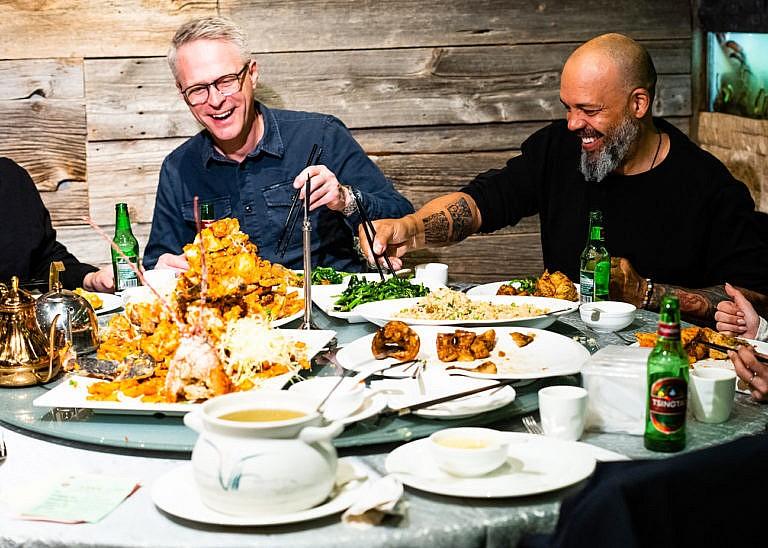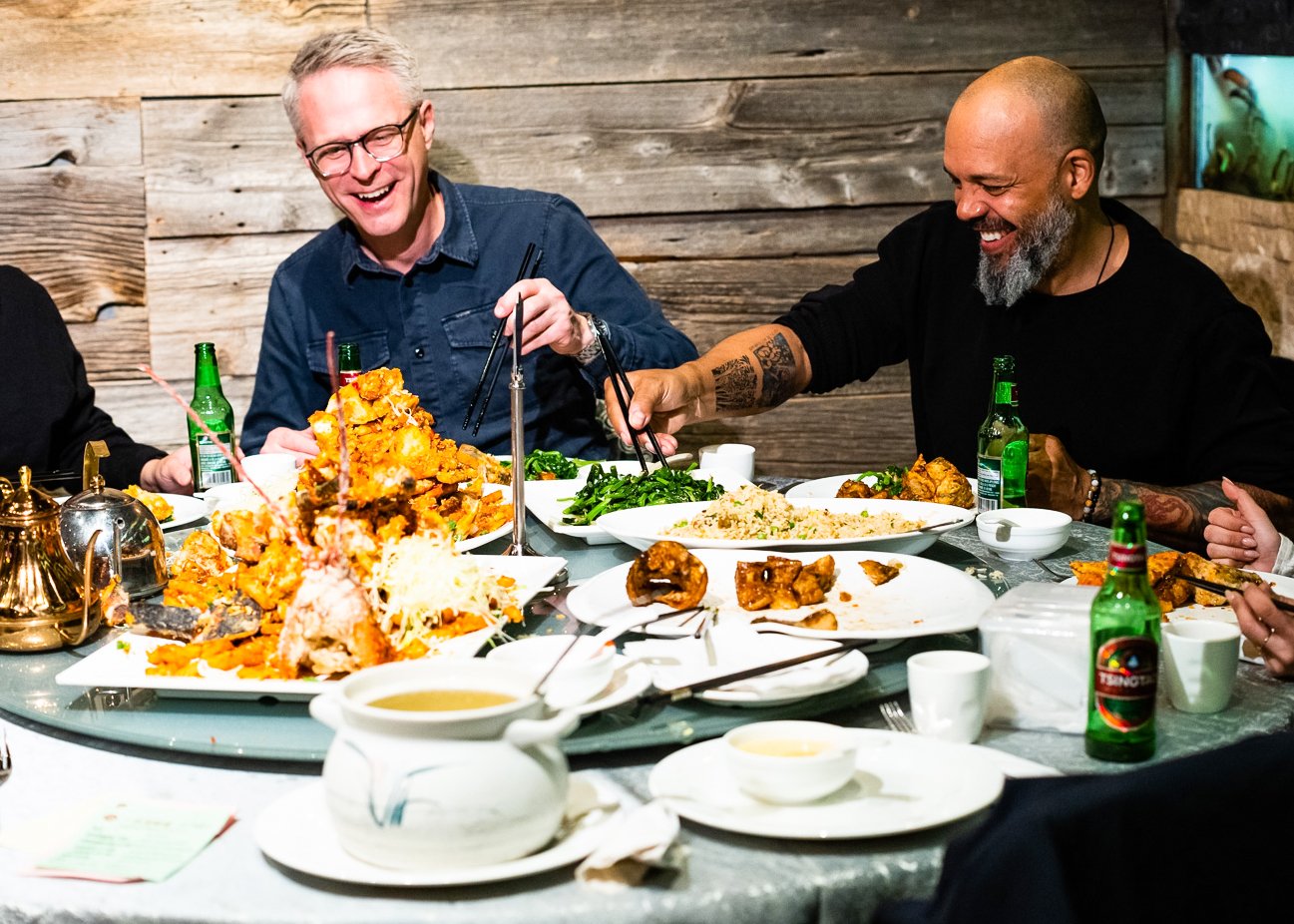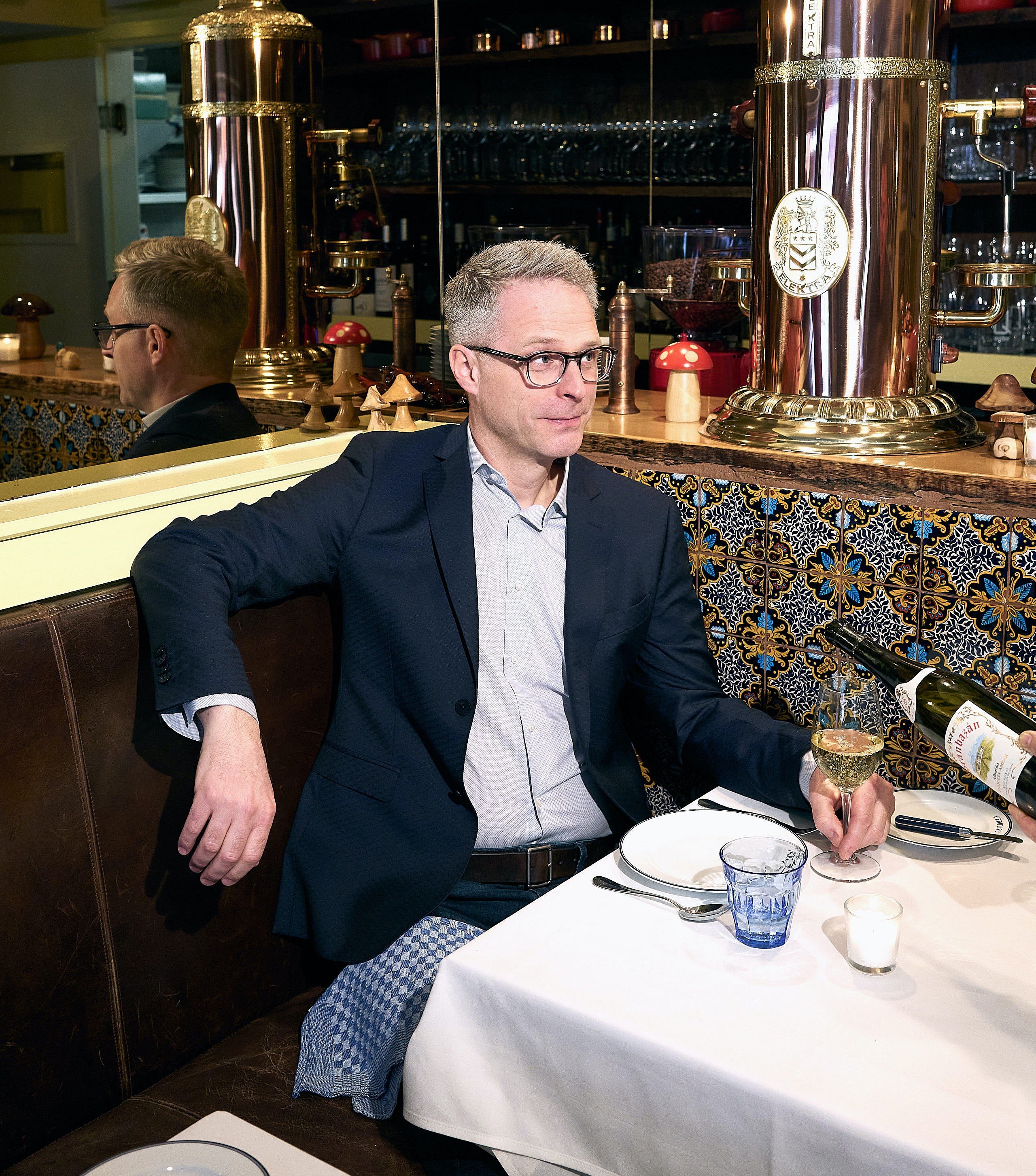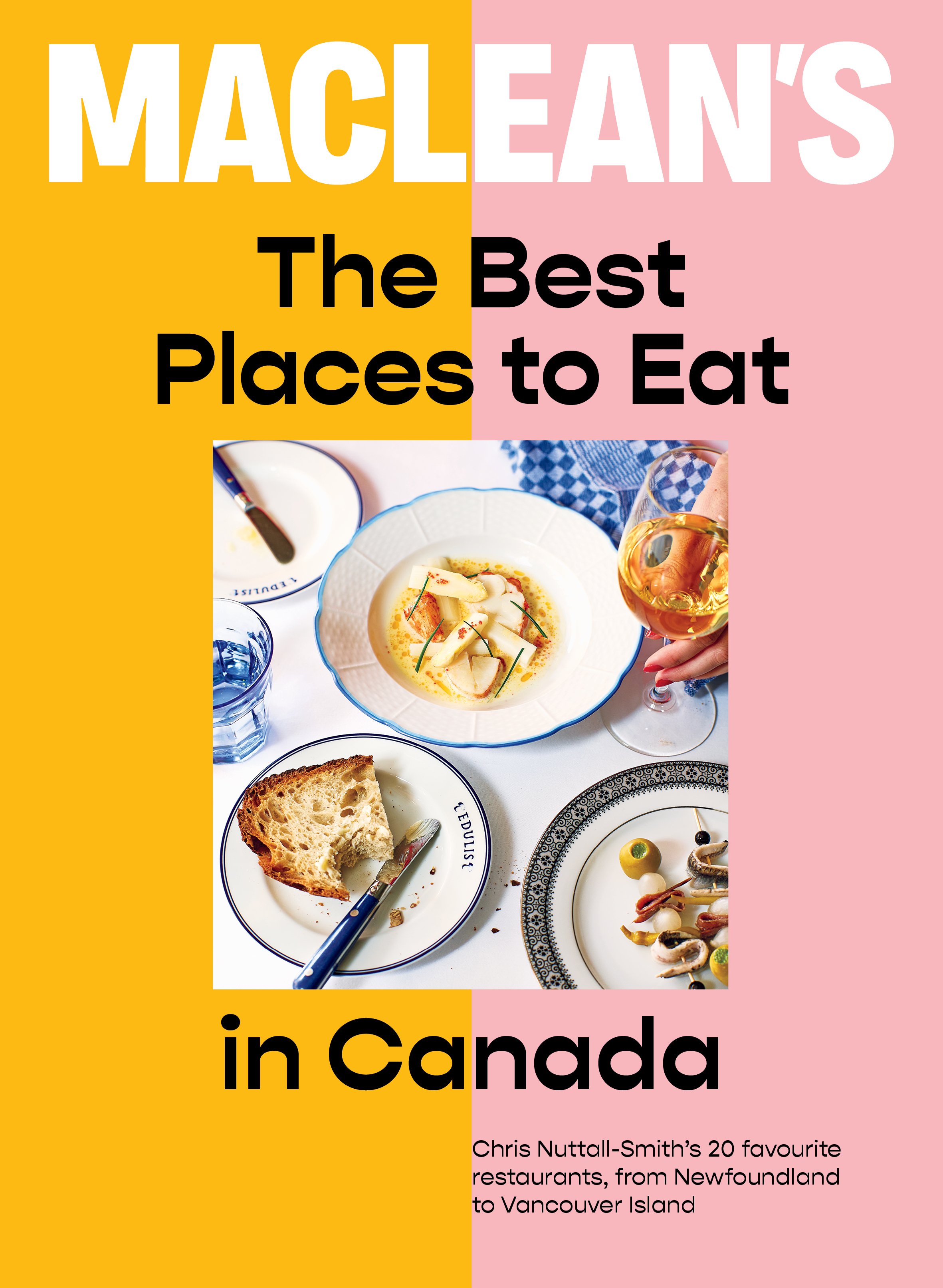A lot has changed at restaurants since the pandemic—starting with how much it costs to eat out
Chris Nuttall-Smith on the great Canadian dining frenzy

Nuttall-Smith and friends feasting on Hong Kong–style lobster at Fishman Lobster Clubhouse, a Chinese party spot in Scarborough, Ontario
Share

It’s funny what happens when you can’t eat in restaurants for a couple of years.
The stop-start reopening of 2022 took all of a heartbeat to become what I can only think of today as the great Canadian dining frenzy—a record-smashing rush of packed rooms and ravenous patrons unleashing our pent-up appetites.
As the dining business began to settle early this year into a new post-pandemic normal, I set out on an epic, 50-restaurant, coast-to-coast eating jag for Maclean’s, gorging my way from Quidi Vidi, Newfoundland, to Ucluelet, B.C. The intention: to take the temperature of the country’s remade dining landscape—and to uncover Canada’s most spectacular restaurants along the way.
At their best, the kitchens and dining rooms I visited ran at a consistently higher level than I’ve ever seen, offering sensational, can’t-do-this-at-home cooking and warm, joyful service. You could tell how happy (and relieved) the staff and owners were to be back. Yet the industry we’ve returned to isn’t the same as before. For many welcome new developments, there have been trade-offs too. The most jarring of these has been the price of eating out.
It might have been the $48-per-dozen local (and completely average) oysters in St. John’s that got me. Not just at one spot, but at almost every bar and restaurant where I could find them. Or the simple weeknight pasta dinner in Toronto with my wife and kid; with just a couple glasses of wine, it came to $170 after tax and tip. The price of a cocktail has edged toward $20 in a lot of restaurants. I saw no end of main courses for $40 and up in what used to be known, I guess quaintly, as “mid-range” spots.
That mid-range, suddenly more expensive almost across the board, has taken a hit in pricier centres, Toronto in particular. Independent, original, professionally run places where you could eat well on a weeknight without too much sticker shock used to be one of the city’s strengths. Now, squeezed by rising food, labour, construction, financing, maintenance and rent costs, a lot of those restaurants have either closed or raised their prices to what many diners consider special-occasion heights. While some people may see those prices as straight-up gouging, in many cases it just isn’t that simple. “I can guarantee you that most of them are barely getting by,” one respected mid-range restaurant owner told me. Through much of the reopening, this restaurateur couldn’t find dishwashers for less than $30 per hour. And because so many veteran floor staff left the restaurant business during the pandemic, they had to train the basics to entire crews of first-time servers, who couldn’t work nearly as quickly or smoothly as the people they’d replaced. Even then, the business couldn’t find enough workers to run at full capacity. They’ve been turning away eager would-be customers while tables sit empty—a phenomenon I’ve witnessed over and over through the past year.
At the high end, where chefs used to hold their breath before charging more than $90 per person, $185 dinners now sell out in a flash. At Toronto’s much-lauded—and, if you’ve got the bankroll, genuinely excellent—Alo, you’re in for $300 a head now after tax and a 20 per cent tip, provided you can get a reservation. And that’s with only tap water to drink. As far as I can tell, the award for Canada’s priciest restaurant goes to Sushi Masaki Saito, in Toronto’s Yorkville neighbourhood, where the pre-drinks price of admission has climbed to $680 per head. Personally, I’d sooner jump on a plane to Japan.
On the plus side, at least some of those bigger dinner bills are paying for long-overdue changes across the industry: higher wages and once unheard-of benefits for many restaurant workers. The four-day workweek has become increasingly common, especially at upper mid-range and higher-end spots. Though 12- and 14-hour shifts are standard still, many cooks can now count on three days of built-in downtime. These aren’t fads. They’re transformational changes, professionalizing an industry that’s been built through much of its existence on staff burnout and turnover. It seems almost crazy to say this, but I’ve heard it from restaurant workers throughout the past year: it’s suddenly possible to work in restaurants and also have some sort of life.
There are still plenty of affordable places, too, of course. Many of the best restaurants in Montreal remain eminently reasonable; the owners of Mastard, an ambitious neighbourhood spot I fell in love with, have made value for money a priority. In Montreal especially, it’s far from alone. For a lot of chefs there, being accessible to friends and neighbours is as important as getting a good sear on a piece of line-caught fish.

I found excellent mid-range options in Nova Scotia too, like Dartmouth’s superb, family-run Canteen. (When it’s available, the restaurant’s lobster and snow crab “crobster” sandwich might just be my vote for the single greatest sandwich on earth.) In Calgary, I found the excellent Ten Foot Henry, as well as Paper Lantern, a second-generation Vietnamese kitchen and lounge tucked away in Chinatown. As a bonus, Paper Lantern’s “better tiki” cocktails were brilliant: tiki-style, but made with rare smarts and balance, and without the usual sickly sweet. And even Calgary’s flashy (if underwhelming) new “high-end steakhouse,” called Major Tom, was priced more like a stealthy mid-range spot, with affordable options hidden between the menu’s attention-grabbing big-ticket spends.
I did double-takes at wine lists across Alberta and B.C. especially; compared to the rest of the country, drinking in restaurants out west can seem almost absurdly cheap. I routinely found good bottles in the mid-$40s range, even from fancy, best-of-class cellars like the one at Calgary’s River Café. At Arike, an ambitious Pacific Northwest–style Nigerian spot in Vancouver’s west end, the wine pairings to accompany chef Sam Olayinka’s one-of-a-kind $75 tasting menu sold, the last time I looked, for just $29.
It’s important to note, too, that even though the mid-range has faded in the priciest centres, it’s far from finished, as the success of standouts like Ottawa’s Supply & Demand and Toronto’s Bernhardt’s shows. And meantime, suburban restaurants—places like my top picks One2 Snacks and Guru Lukshmi—are more appealing than ever; they’ve been the mid-range (and lower-end) heroes all along.
Another major impact of the restaurant boom: reservations at the most popular places have become a blood sport. At Vancouver’s AnnaLena, to cite just one, you should be online at precisely 9 a.m. PST a full 30 days (no more, no less) before you hope to dine. At many other places, a two-week wait for non-prime nights and times has become the standard. The upshot? At a popular spot with a bit of hype behind it, you might be able to find a Tuesday evening table at 5 p.m.—if you’re the sort of person who thinks to book your Tuesday dinners several weeks in advance.
How people dine once they get through the doors has also undergone some dramatic changes, the most consequential of them the rapid adoption of tasting menus at the upper mid-range and high end. Even three or four years ago, tasting menus were generally seen as high-risk rarities, reserved for only the very best or most brazen places. (And also for sushi counters. Diners seem to love omakase sushi.) Today, they’re quickly becoming standard operating procedure, not merely among established, higher-end spots—Edulis and Alo in Toronto, St. Lawrence, Burdock, Kissa Tanto and Maenam in Vancouver, and too many more to name—but also for many untested chefs.
At their best, tasting menus are a brilliant way to eat out. Kitchens can focus on only their best work and ingredients, nimbly adjusting their menus day-to-day to feature new ideas and peak-season product, and serving them so a meal unfolds as a thoroughly considered—and most importantly, delicious— experience from beginning to end. (You’ll find the greatest of those places on my list.) Yet the chefs and restaurants that manage to do that while truly putting the diner first remain a rarity. In spite of those menus’ surging popularity, their benefits most often accrue to the house. Tasting menus bring a rare degree of predictability to running a restaurant; it’s exponentially easier to control costs when you know in advance exactly what your customers are going to eat. And they also guarantee a minimum spend, so that diner who used to order a salad and an appetizer and a glass of tap water while—to put it bluntly—taking up a valuable seat, has no choice now but to drop $125 (or in many cases, far more) for the “menu degustation.”
That tasting-menu craze is also being driven by the dawn of tourism board–funded Michelin ratings in Vancouver and Toronto. It’s hard not to feel that many places are playing more to the inspectors’ fondness for static and perfectable multi-course menus and fancy decor than to legitimately seasonal, market-driven cooking, or, God forbid, what their customers want. Another Michelin-related phenomenon I witnessed time and again on my travels: a notable rise in what I think of as the moneyed checklist star-chaser. They’re the seen-it-all, tried-it-all types who look utterly bored and disengaged as they work through their dinners, but nonetheless photograph or video almost every single bite. Increasingly, diners are required to pay in advance, too. As for cancellations (too bad, friend) and no-shows (for a full refund, please dial 1-800-SUCK-IT), they’re on their way to extinction.
When you add all those phenomena together—pre-paid bookings, the rise of tasting menus, cash-flush diners and the continued ascent of a social media–fuelled hype economy—they can do some immense good. These are the same innovations that allowed scores of pandemic-era pop-ups, takeout businesses and small-time foodpreneurs to thrive; since the great reopening, many young and lesser-known chefs without the old-style professional or economic capital have harnessed that model to build DIY hospitality careers. And especially at the higher end, eating out in fancy restaurants is supposed to be a luxury. Even many of the priciest places in Canada are still a steal when compared to international dining towns. Yet the big “if” behind so many of these changes is how well they’ll stick once the dining frenzy ends.
Pre-pandemic dining was mostly a buyer’s market, in which customers were always right and many restaurateurs kept a lid on prices by taking advantage of their staff. Through the post-pandemic reopening, the pendulum then swung hard the other way.
In making my best list, I stayed hyper-attuned to where individual contenders fell on that spectrum. I ate in buzzing taco shops and boisterous ramen-yas, Tamil snack counters, pasta joints and an Indigenous pop-up. I tried luxe, high-French restaurants and dosa houses, dim sum and seafood and Nigerian cooking specialists, wine bars, Middle Eastern, South American and Southeast Asian spots, and an extremely earnest tasting-menu place where they make the bathroom’s hand soap from used coffee grounds and cooking grease. (Please: don’t ever.) No matter where I travelled, I watched for restaurants that had warm service, reasonable value, spectacular cooking and, as always, a sense of genuineness and joy. And the good news? I found them in almost every city I visited.
I can’t help thinking we’ll be seeing many more of them too—that the great dining frenzy, and that perpetually swinging pendulum, might soon settle out at a comfortable mid-point, where for once, just maybe, everybody wins.
Chris Nuttall-Smith travelled cross-country to find Canada’s most delicious places to eat. Here’s his list of the country’s 20 most magical restaurants, from the tip of Vancouver Island to the edge of Newfoundland.
This article appears in print in the May/June 2023 issue of Maclean’s magazine. Buy the issue for $9.99 or better yet, subscribe to the monthly print magazine for just $39.99.
